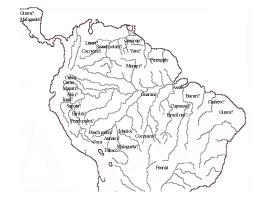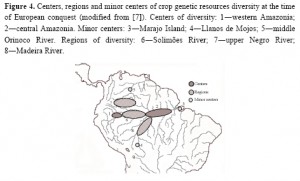- RBG Kew launches new website. Busy, busy, busy.
- Turkeys domesticated twice, neither time in Turkey. Gobble, gobble.
- Warmer-than-expected weather hits Thai sugar production. Sweet.
- Climate shocks hit poor countries’ exports. Shocked. h/t Cecilia.
- Biodiversity law could stymie research,” and that’s all I know, because the rest is behind a paywall. Access and benefit share THIS!
Cracking the code of dog diversity
Another contribution from Michael Kubisch.
Ever wondered why your rat terrier looks so different from your neighbor’s mastiff? Well, eons of selective breeding, of course, which have resulted in genetic differences between these two and other dog breeds. Man’s best friend was undoubtedly among the very first animals to be domesticated, although the huge variety of breeds found today is probably a much more recent phenomenon. Which part of the dog genome, or more pertinently which genes, were involved in generating this diversity remains largely a mystery — but one that many geneticists would like to solve.
A first glimpse has now been provided by a group of scientists who compared genomic data from dogs belonging to ten different breeds using what is called single-nucleotide polymorphisms or SNPs for short. SNPS are very helpful because the presence of a particular SNP sometimes is indicative of the presence of a specific allele at a nearby gene. Similarly, if there are SNPs that differ between two dog breeds it is possible that nearby genes may be different as well and that those genes may have played a role in what sets these breeds apart.
The study revealed 150 areas of the dog genome containing more than 1000 candidate genes that appeared highly variable between those breeds that were examined. Not surprisingly perhaps, several of these genes are known to determine things like coat color, size, skeletal morphology and behavior. However, interestingly, several candidates included genes that are known to act as regulators of other genes, suggesting that some evolutionary changes are not the result of variant alleles of genes but changes in how these genes are controlled. More interesting insights are sure to follow.
Bread or beer? Why choose?
The Cartesian Dualists of the press, if not those of the hallowed groves of academe, are at it again. Der Spiegel, 1 late last month, and The Independent, late last week, report on Professor Patrick McGovern’s latest book, Uncorking the Past: The Quest for Wine, Beer and Other Alcoholic Beverages, almost entirely in terms of which came first, beer or bread.
All the familiar old arguments are trotted out. That bread is actually quite hard to make, while a forgotten soaked seed or rotten fruit is easy enough to swallow and packs enough punch for the brain to say, in Der Spiegel’s memorable phrase, “whatever that was, I want more of it!”. But this convenient opposition ignores things like porridge or gruel, both of which probably represent easier ways of consuming cereals than bread. 2 Most cereals don’t even make very good bread, at least not as it is understood by European journalists.
Professor McGovern, who runs the delightfully named Biomolecular Archaeology Laboratory for Cuisine, Fermented Beverages, and Health at the University of Pennsylavania’s Museum of Archaeology and Anthropology, is actually claiming far more than that beer came first. He seems to be laying nothing less than the development of settled agriculture, and with it civilisation as we know it, at the door of drunks. According to Der Spiegel:
[A]griculture — and with it the entire Neolithic Revolution, which began about 11,000 years ago — are ultimately results of the irrepressible impulse toward drinking and intoxication.
“Available evidence suggests that our ancestors in Asia, Mexico, and Africa cultivated wheat, rice, corn, barley, and millet primarily for the purpose of producing alcoholic beverages,” McGovern explains. While they were at it, he believes, drink-loving early civilizations managed to ensure their basic survival.
He knits together all sorts of fascinating evidential threads, and at least as far as the articles go, makes a convincing enough case. But then, I remain deeply skeptical of single explanations for anything as complex as the evolution of settled agriculture. And I suspect McGovern does too. As he told The Independent:
As for his theory on how alcohol motivated man to adopt agriculture, McGovern said: “I just wanted to put it out there as a worldwide hypothesis. Then over time maybe the different pieces can be put together from across the world.”
I’m trying really trying to avoid this, but I can’t: I’ll drink to that.
Amazonian agriculture analyzed
I don’t know about you, but in my laziness I sometimes catch myself making the assumption that a centre of crop origin is also one of crop diversity. That is of course sometimes the case, but by no means always, as Vavilov himself recognized. A recent open access paper in Diversity makes the point very clearly. 3
The authors, led by Charles R. Clement of the Instituto Nacional de Pesquisas da Amazônia in Manaus, review molecular studies and also bring in archaeological and other evidence in their discussion of the history of Amazonian crops. They come to the conclusion that these crops originated around the periphery of the region: “All but one of the species examined originated in the periphery of Amazonia (Figure 3), rather than along the major white water rivers where pre-conquest population densities were greatest.” Here’s that Fig. 3:
Now, in contrast, here’s where the pre-Columbian hotspots of diversity were to be found: “The major centers and regions of diversity are along the major white water rivers and in northwestern Amazonia, where ethnic diversity is extremely high.”
The explanation, according to the authors, is the length of time involved in the development of agriculture in the region.
Because crop domestication began thousands of years before food production systems became important, it is not at all surprising to see a dramatic contrast such as that in Amazonia.
Why was the Amazonian periphery such a focus of domestication?
It is possible that sufficient natural resources were available [in central Amazonia] so that the home gardens were such a small fraction of subsistence that they are difficult to find in the archaeological record. In contrast, in the headwaters of the same rivers in the periphery, less abundant aquatic resources may have increased the importance of home gardens.
Nibbles: Dogs dedomesticated, coffee, climate change squared, Rice. Carnival
- Dogs live wild run free in Moscow.
- Climate change and coffee. CIAT rules.
- “Reasons to be optimistic”: Jarvis on Copenhagen.
- “The meeting did deliver”: DFID blogger on Copenhagen.
- Jazzman rice. Say it loud, it’s Murcan and proud. h/t James.
- Scientia Pro Publica, the blog carnival, is up, with added capuccino madness

